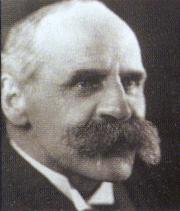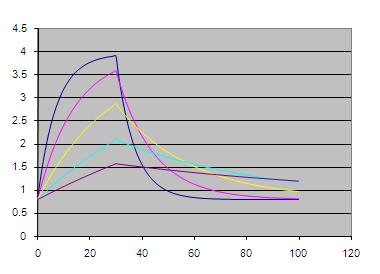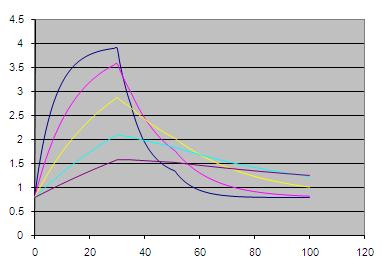Decompression theory for goats
part one.
Full screen
We divers all have a sneaking suspicion that we ought to know more about
decompression theory than treating tables as gospel or just watching the
computer and being hopeful that the people who make it knew what they were
doing.
Well I did so I read the books rather than doing my own research.
 The first real work on the subject was Dr. John Scott Haldane who got a British
Navy budget to try and make divers last longer. They were expensive to train
and expensive to retire when the MO said they were unfit for further service.
He knew the basics, that nitrogen dissolved in the diver's blood and when they
came up it undissolved and it hurt and sometimes they fell over and had to be
carried off to sick bay.
The first real work on the subject was Dr. John Scott Haldane who got a British
Navy budget to try and make divers last longer. They were expensive to train
and expensive to retire when the MO said they were unfit for further service.
He knew the basics, that nitrogen dissolved in the diver's blood and when they
came up it undissolved and it hurt and sometimes they fell over and had to be
carried off to sick bay.
So in 1905 Haldane started a series of experiments in a compression chamber
that today would have the animal rights people up in arms. However in those
days Haldane escaped vilification as a serial goat bender and worked back from
what he saw to the underlying conditions below and laid the foundations for
modern decompression medicine.
Boycott AE, Damant GCC, Haldane JS. The prevention of compressed-air illness.
Journal of Hygiene. Cambridge 1908
Haldane's model of nitrogen and people says that for any bit of your body there
is a rate that nitrogen, or any other inert gas, builds up. He had Henry's law
that says that the amount of gas that will dissolve is proportional to
the partial pressure of that gas applied and Haldane needed to put time to
that. In essence he discovered that the gas dissolves at a rate that is
proportional to the difference from the final value of the current value. So if
we know the level we are moving towards is 10 units and we are at 8 units the
rate is based on the difference 2 units so it is twice as fast as if we were at
9 units (difference 1) but only half that if we were at 6 (difference 4).
Usefully the rate of undissolving works the same way more difference equates to
a faster change.
This is an exponential and is mathematically easy to model but Haldane soon
realised that what may work for a liquid in a jar, which has a simple constant
called a half time, does not work for a goat. The simple liquid has a number
that represents the period of time it takes for the dissolved gas to move half
way to the final value so if the half-time is 10 minutes and the initial
difference is 12 units then after 10 minutes the difference has dropped to 6
units, after 20 minutes it is down to 3 units and after half an hour it is only
1.5 units. You will notice that it keeps getting closer but never gets
there.
Haldane's best trick was to realise that he did not need to model every bit of
a goat and know its half times. He just needed to have representative numbers
that were near enough so that their effects overlapped. These are called
Compartments.
Haldane's other discovery was that once the partial pressure of dissolved
nitrogen was double the absolute pressure it started to spontaneously
undissolve and you got bubbles. Now double is considered a bit
simplistic these days but it was a lot better than nothing. Haldane's table
kept divers below the critical 'double' and stopped the British Navy routinely
bending divers and reduced the Admiralty's bills.
OK? Well let's bend a goat on a 40 meter dive.
 The graph represents the nitrogen tension in the five Haldane compartments
vertically in bar with the time in minutes horizontally.
The graph represents the nitrogen tension in the five Haldane compartments
vertically in bar with the time in minutes horizontally.
Surface ppN2 is 0.79 bar so that is where all our graphs start. At
40 meters it is 3.95 bar so that is where they are heading some fast and the
others more slowly although none will get there. Our goat needs to worry about
compartments with a tension (like partial pressure but for dissolved gases) of
2bar or more on surfacing (double the absolute pressure).
The problem with compartments is that blood is fast, that is it has a short
half time and takes on enough Nitrogen to be a problem long before bone has
accumulated enough to care about but conversely after a long dive the nitrogen
in the bone takes a long time to dribble out so the blood may be decompressed
but you still need to stay down. Haldane used five half times in his model and
his first dive tables were based on the idea of adding up the nitrogen
dissolved and subsequently undissolved in half times of 5, 10, 20, 40 and 75
mins. Look at the graph. They start at 0.79 bar, that is the nitrogen in normal
pressure air, and the target is 3.95 bar which is the nitrogen in air at 40
meters. You can see the 5 minute compartment (blue line) shoots up and get very
close. The 10 minute compartment (purple) goes slower and never gets above 3.6
in the half hour under pressure. The 75 minute compartment (cyan) only gets to
1.6. After half an hour the outside pressure reverts to 1 bar and the poor old
goat decompresses like a freshly opened can of coke. Notice that the 5 minute
compartment is virtually clear by 70 minutes but by 100 minutes the compartment
with the most nitrogen is the 75.
Now if the bend limit was 2bar (double the absolute pressure) this was one
badly bent goat when he stepped out of the chamber.
 Not much good that one. Goat for supper again. Right get me another goat and
we'll give this one a couple of deco stops.
Not much good that one. Goat for supper again. Right get me another goat and
we'll give this one a couple of deco stops.
The compartment with the most nitrogen after 30 minutes is the 5 minute one
(blue) with 3.9 bar so if we are not to let the absolute pressure go to less
than half the tissue tension we'd better stop him at 10 meters, 2 bar. We'll
keep him there for five minutes, i.e. thirty five minutes into his
dive.
Look at the graph. The 5 minute compartment rushes down towards 1.58 bar being
the ppN2 in air at 2 bar but the 75 minute compartment is unchanged as 1.56 is
just where it is so it has virtually no reason to change.
I'm sorry but the kinks at 35 minutes are a bit hard to see but our worst
nitrogen level at the end of the stop is now 2.97 bar so we can afford to take
our goat to a level that is half that i.e. 1.5 bar so let's give him a 5 meter
stop where the absolute pressure is 1.5 bar and he can stay here till it is
safe to surface.
To surface the max ppN2 must be less than 2 bar which happens
at 52 minutes when the 20 minute compartment finally falls below the limit.
Time to knock off for the afternoon and take our remaining goat down the pub
for a beer but he is still decompressing. Watch my graphs. After 100 minutes
from the start of his dive he still has 1.125 bar of nitrogen in his 75 minute
compartment. Remind this goat not to fly.
In part two we will discuss slightly more recent
improvements to the plan.

by Nigel Hewitt
Back to the Diving Page
 The first real work on the subject was Dr. John Scott Haldane who got a British
Navy budget to try and make divers last longer. They were expensive to train
and expensive to retire when the MO said they were unfit for further service.
He knew the basics, that nitrogen dissolved in the diver's blood and when they
came up it undissolved and it hurt and sometimes they fell over and had to be
carried off to sick bay.
The first real work on the subject was Dr. John Scott Haldane who got a British
Navy budget to try and make divers last longer. They were expensive to train
and expensive to retire when the MO said they were unfit for further service.
He knew the basics, that nitrogen dissolved in the diver's blood and when they
came up it undissolved and it hurt and sometimes they fell over and had to be
carried off to sick bay. The graph represents the nitrogen tension in the five Haldane compartments
vertically in bar with the time in minutes horizontally.
The graph represents the nitrogen tension in the five Haldane compartments
vertically in bar with the time in minutes horizontally. Not much good that one. Goat for supper again. Right get me another goat and
we'll give this one a couple of deco stops.
Not much good that one. Goat for supper again. Right get me another goat and
we'll give this one a couple of deco stops.